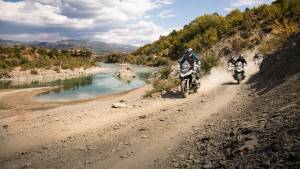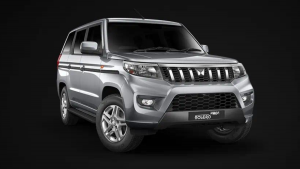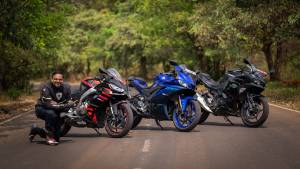The spy who shoots cars
Team OD
Published: August 25, 2011, 11:21 PM IST
You've seen them, right? Blacked-out, stickered-up cars that look rough and tatty but essentially formless, peering back at you from grainy pics in a magazine or on a website, usually bearing either a large exclusive tag or an equally large copyright. No manufacturer wants its forthcoming products exposed before they're ready to meet the public. The automotive spy photographer takes it upon himself to capture these very cars and motorcycles on the street during the testing phase. The cladding, the stickering and lately fake bodywork are all there to camouflage the vehicle and once again, it is up to the photographer to find and work around the deception. To learn more, we spent a day with Rohit Chandrasekharan, who has earlier sent us a whole slew of spy pics and then recently joined the editorial team.
What he told us straight away is that it isn't easy and that it is a hard life. Rohit is based out of Pune which is blessed with a whole lot of car manufacturers. Having developed an interest early, he started to notice these test cars on the roads about town and then started photographing them. Photoshopping the cladding or stickers off to reveal what lay beneath was the logical next step. When OVERDRIVE published an exclusive picture sent by Rohit, it cemented his interest in the whole business and confirmed his knack for finding and snapping vehicles in testing. His passion for automotive design only helped.
Gaurav and I met Rohit outside the Tata Motors plant at 6am. Rohit is on the trail of a Tata Safari prototype that's been doing the rounds. Catching the prototypes isn't easy, of course, but some idea of normal test schedules helps, as does an idea of where these prototypes usually go for testing. Over the years, Rohit has made a list of locations the prototypes frequent. But he warns that the window of opportunity is mere seconds and you must be ready to snap the pic in split seconds, ideally catching front, side and rear shots to be able to piece together an artist's impression of the car. He likes to supplement his stills with video when possible so that you can use screen grabs to get an idea of the lines

and angles.
Rohit installed us in one of the 'hiding places' before heading out to locate the prototype â" he said he would call as he followed the vehicle towards us. Gaurav's task was to shoot Rohit in action â" much harder than spy photography itself. Gaurav's patience was at an ebb after an hour of waiting as the day got hotter. Then Rohit called to say that he was on the way. We spotted a Safari-sized car wearing full canvas covers with Rohit in tow on a bike, his friend riding pillion and taking photographs. As soon as Gaurav was done, we hopped into our car and followed the prototype.
Rohit knew the fuel station the prototypes used regularly and we headed out confidently. As it turned out, we had ample opportunity to shoot as the car halted at a traffic signal and then to fill up at the pump.
Sounds easy? Rohit says the test drivers can be aggressive, snatching away cameras if they spot you taking pictures so it's best to not hang about. Ideally, the spy photographer avoids detection with a good hiding place or being in the right place before time. A driver had, in fact, snatched Rohit's camera earlier, thankfully returning it after deleting the pictures on it. The next step once you have basic exterior shots is to zoom in on details to complete the rendering. In our case, by this time, the driver had spotted us and was getting worked up so we decided to call it a day.
On the way home, I quickly surfed up some spy photography history and discovered that an American woman called Brenda Priddy is known as the mother of spy photography and her company today supplies spy photographs all over the world â" it's a booming business. Perhaps the most famous spy photographer though is the now retired Hans Georg Lehmann from Germany. At a young age, his family moved to Wolfsburg where he developed his interest in cars. In the 1960s, he worked as a photographer for a news agency and freelanced for daily newspapers and usually used to carry his camera wherever he went. In the year 1963, at the nearby Volkswagen factory, he came across an unusual looking car and using his 300mm lens he took some pictures. Those pictures were sold to a newspaper company for a healthy sum of money. The prototype in question turned out to be a proposed replacement for the Volkswagen Beetle.
All the stories suggest that the art requires infinite patience, some luck and a lot of hard work. If you start making money, better photography equipment obviously also helps.
When we got to Rohit's place, his excitement was palpable as he downloaded the pics on to his computer. We'd gotten lucky to have such a comprehensive set of pictures without incident on a single day. Rohit has spent days shooting to get enough material to render a single prototype, more often than not.
Ultimately it would take the man nearly two days of peering at the shots to piece together a cogent rendering. He says an eye for detail and some grasp of how certain companies approach design help immensely in producing accurate renderings. I marvelled at the way he teased out details like the projector headlamp, twin exhausts and the new front grille from mere hints and shadows in the cladding.
Technically, we believe there is nothing illegal about shooting whatever is in a public place and as such, spy photography, as far as Indian laws are concerned is not illegal on the face of it. But the danger of retaliation is real. If it comes to fisticuffs â" and it has in the past â" the camera will usually be the victim.
Spy photography is already big enough in Europe and America to support careers. But in India, this is still a nascent art. As India's hunger for cars and motorcycles grows, so will the consumers desire to know earlier and earlier what is likely to come to showrooms. In time, as India becomes more important as a testing and R&D hub, the scope of what you can capture will only increase. In the meantime, if you'd like to dip your toes in these waters, keep patience, a camera and an eagle eye ready.
Price (Ex-Delhi)
Starts Rs 14.99 Lakhs
Starts Rs 14.99 Lakhs
Displacement
1956cc
1956cc
Transmission
Automatic
Automatic
Max Power(ps)
170
170
Max Torque(Nm)
350
350
Mileage
-NA-
-NA-
Related Stories
Top Stories
Latest Videos
Most Popular
Network18 Updates
Compare














